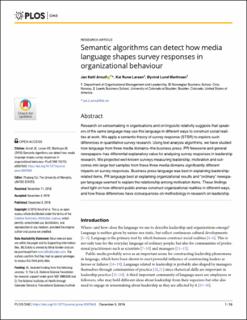Semantic algorithms can detect how media language shapes survey responses in organizational behaviour
Peer reviewed, Journal article
Published version

Åpne
Permanent lenke
https://hdl.handle.net/11250/3010547Utgivelsesdato
2018Metadata
Vis full innførselSamlinger
- Scientific articles [2181]
Sammendrag
Research on sensemaking in organisations and on linguistic relativity suggests that speakers of the same language mayusethis language in different ways to construct social realities at work. We apply a semantic theory of survey response (STSR) to explore such differences in quantitative survey research. Using text analysis algorithms, we have studied howlanguage from three media domains–the business press, PR Newswire andgeneral newspapers–has differential explanatory value for analysing survey responses in leadership research. We projected well-known surveys measuring leadership, motivation and outcomesinto large text samples from these three media domains significantly different impacts on survey responses. Business press language was best in explaining leadershiprelated items, PR language best at explaining organizational results and “ordinary” newspaper language seemed to explain the relationship among motivation items. These findings shed light on how different public arenas construct organizational realities in different ways, andhowthesedifferences have consequences on methodology in research on leadership.
